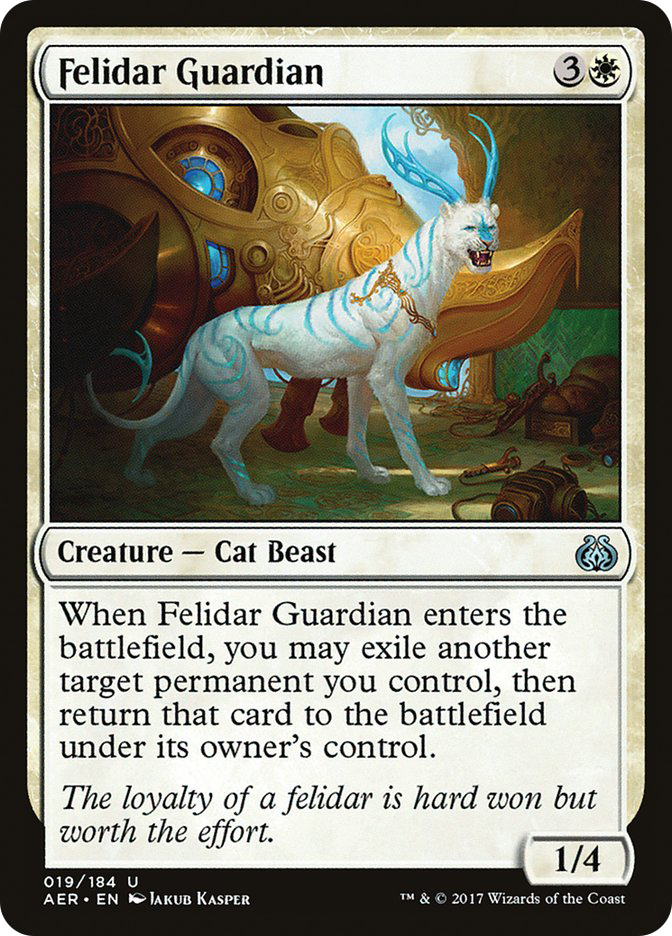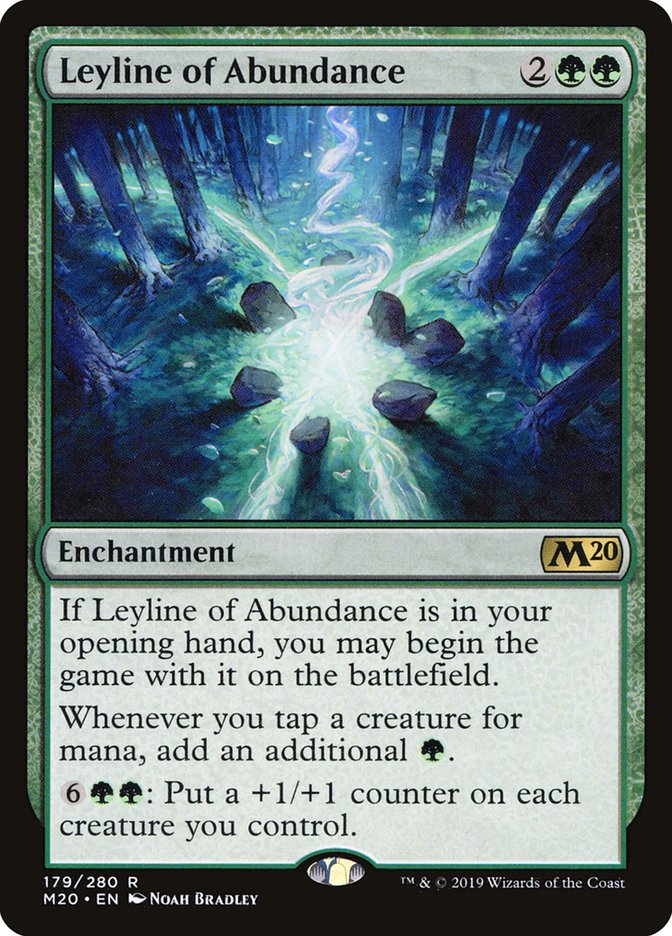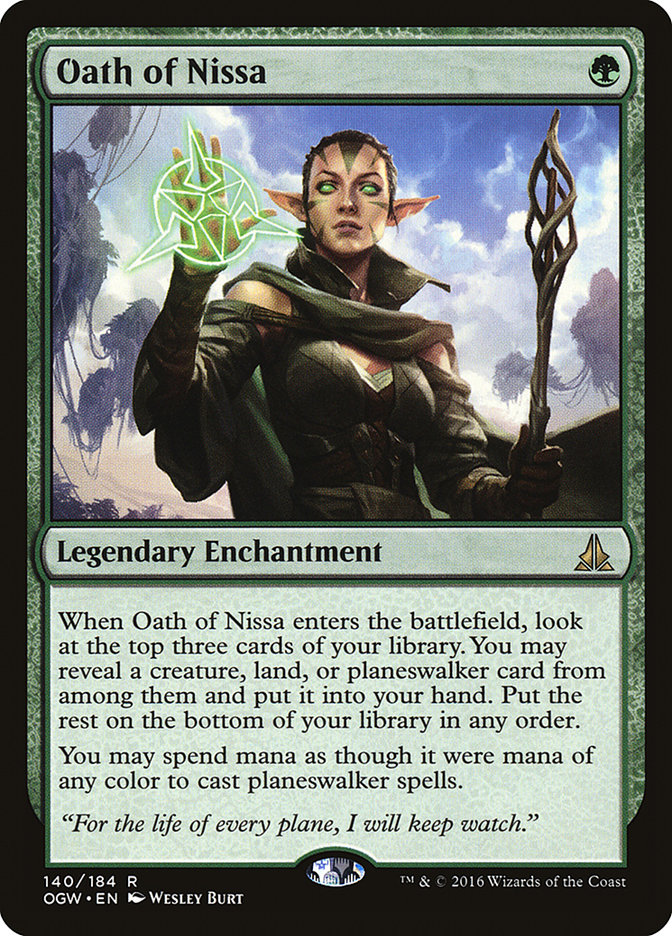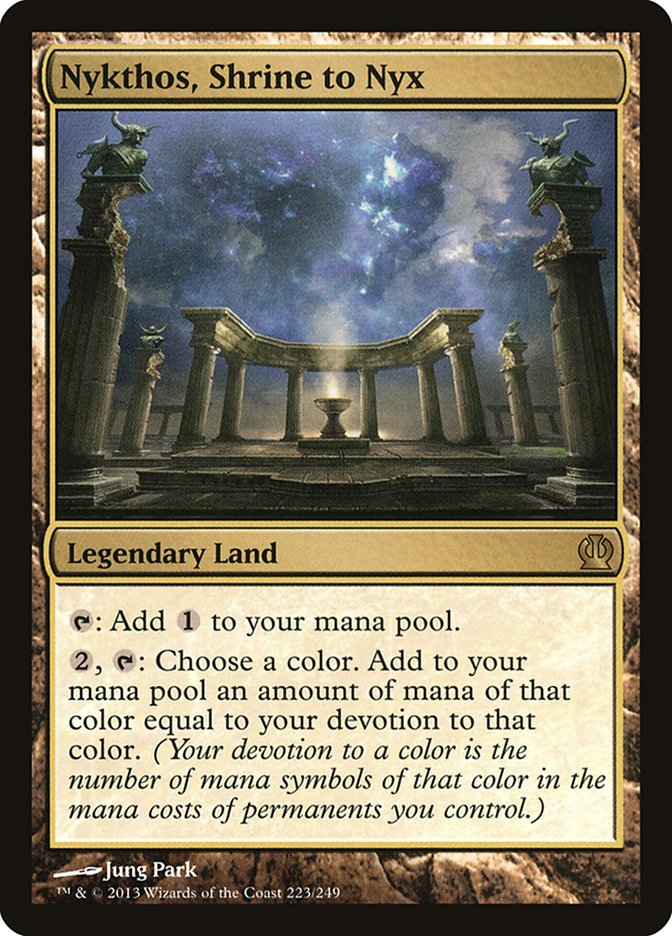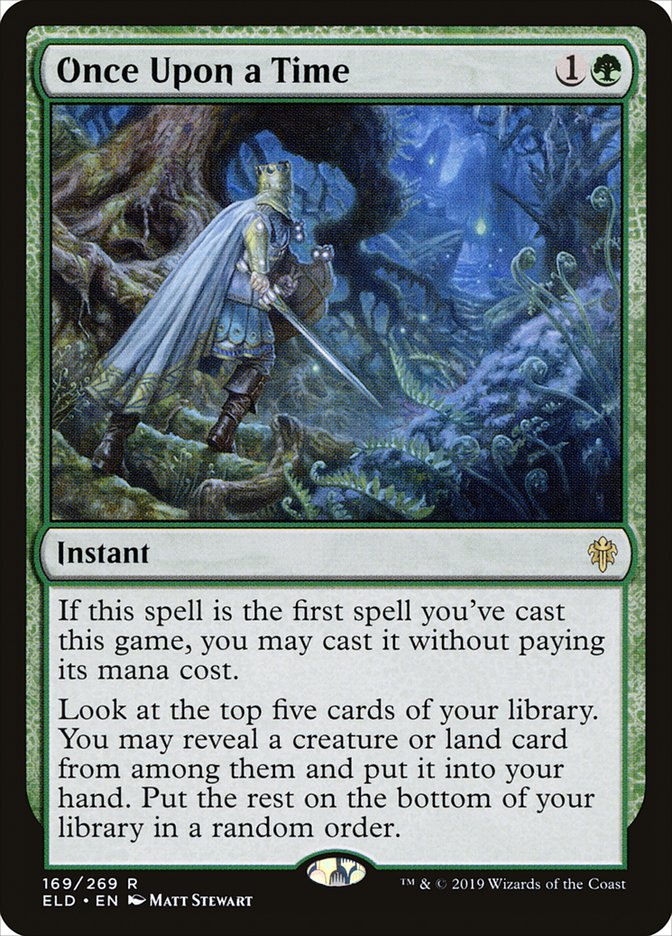The first victims of the Pioneer format’s aggressive approach to bans have fallen, and it’s hard to feel much sympathy for the cards now riding the pine.
We all knew Felidar Guardian was not long for the Pioneer format, and the fact that it got any time to do its thing might be more surprising than its banning. There is a reasonable argument to be made that the constraints that Cat Combo placed on the format could briefly function as net positives. Creature removal and early interaction form a good starting point for exciting gameplay and meaningful decisions.
However, like the Splinter Twin analog in Modern, the combo is just too ruthlessly efficient at what it does. Punishing every other deck when the format gets too wide to include adequate sideboard and maindeck answers sets artificial limitations on the potential diversity of the format. Felidar Guardian decks were only going to get better as the format went on, and as their other angles of attack figured the correct axis, playing against the deck would quickly become a frustrating experience. In summation, good riddance.
When it comes to Leyline of Abundance and Oath of Nissa, it feels like these bans were judgement calls. Leyline of Abundance is likely dying for Nykthos’s sins. There is a return to Theros right around the corner. Maybe there is a good amount of interesting gameplay to squeeze out of Nykthos that doesn’t feel quite as broken as Mono-Green Devotion’s absurd “fifteen mana on Turn 3” starts.
Oath of Nissa strikes me as a weaker card than Once Upon a Time by a good margin. Banning Oath does slow down a Kethis deck that looks like it is starting to get tuned, but the goals of an Oath ban feel a bit more nebulous to me. I don’t think anyone would argue that green isn’t in need of some nerfs, though. Why let them easily cast all the busted three-mana planeswalkers? Let’s at least let them miss a secondary or tertiary color occasionally.
Ultimately, we’re splitting hairs here. The right decks ate nerfs, and now we are granted with the greatest gift you can bestow upon a Magic player—a new format to figure out. Tom Ross will go deeper on some decks that are completely unlocked by these bans, but I want to take a more measured approach and identify what the impact of these bans are on the decks already sitting near the top tiers of Pioneer. Let’s start with the biggest losers.
Loser: Hardened Scales
Creatures (24)
- 4 Steel Overseer
- 4 Hangarback Walker
- 2 Metallic Mimic
- 4 Winding Constrictor
- 2 Rishkar, Peema Renegade
- 4 Walking Ballista
- 4 Stonecoil Serpent
Planeswalkers (2)
Lands (21)
Spells (13)

Note that this list comes from the Magic Online Leagues and not the PTQ or Pioneer Challenge. That’s because Hardened Scales was completely blanked in both those events. Many, including me, were high on this archetype going into the start of Pioneer events, but things haven’t panned out as expected, and I’m afraid things are only going to get worse.
Hardened Scales actually had reasonable plans against Mono-Green Devotion and Copy Cat. The deck packs early disruption in the form of Thoughtseize and Fatal Push backed up by a reasonable clock and potentially the most meaningful disruptive creature in the entire format in Walking Ballista. And yet, no results. Now, in the aftermath of bans to the two decks with the most pronounced weakness to Walking Ballista, where is Hardened Scales supposed to get an edge?
You can make the argument that a step away from the former poles of the format benefits Hardened Scales, which is more of a midrange deck then its pedigree suggests. But this deck was the midrange deck which was happy to interact with Devotion’s mana creatures and Saheeli Rai’s precariously low loyalty. When these threats are replaced by Kethis and Hour of Promise or Splendid Reclamation-fueled ramp, Hardened Scales interaction becomes much worse, and the clock is still lacking. Hardened Scales is not the only midrange deck about to feel the pinch of a new set of threats.
Loser: Izzet Phoenix
Creatures (10)
Lands (20)
Spells (30)

Izzet Phoenix similarly benefitted from the fact that a bunch of spells the deck already wanted to be playing lined up extremely well against Mono-Green Devotion’s and Copy Cat’s gameplans. With twelve one-mana removal spells and plenty of ways to reload, no deck came more ready to disrupt infinite Cats at such a low cost. Early mana creatures were likewise punished. Unfortunately, the absence of these two threats from the format will highlight Izzet Phoenix’s many weaknesses.
First, Izzet Phoenix’s clock remains anemic in most circumstances. It takes true outlier draws and fortunate self-mills to end the game with any kind of alacrity. Secondly, Izzet Phoenix has a glaring and undeniable weakness to any graveyard hate, and the options for sidestepping this problem are nowhere near as good as they were in Modern. I’m not saying you should regret having added Treasure Cruise to your arsenal, but you certainly feel the sting of effective graveyard hate more than ever before. I think the correct move in sideboard games will prove to be Brazen Borrower, but the resulting deck left behind is nothing special in comparison to the high power level of the rest of the format.
Izzet Phoenix likely moves from great to good after these bans. I’m not counting it out, but I’m no longer excited to play it.
Loser: Mono-Red Aggro
Creatures (17)
Lands (18)
Spells (25)

I was stoked to see Kanister pick up maindeck Searing Blood, as I think it was a real missing piece from some other Mono-Red lists. It’s dead against very few decks in the format, and it’s one of the few Mono-Red cards that actually keeps pace with the rest of the format on raw power. The burn spells in this deck are laughably bad, but when they were providing you with counterplay to the two best strategies in the format, you could make a case for their inclusion. Now, you are just left playing worse spells than everyone else. It’s hard to remember that we only recently accepted Shock as a constructed playable Magic card in Standard. I don’t think I want to lean in to eight copies in Pioneer. Instead, I want my aggressive decks to pick up some larger persistent sources of damage, and maybe even a free spell or two.
And the first of our winners does exactly that.
Winner: Gruul
Creatures (30)
- 4 Burning-Tree Emissary
- 4 Experiment One
- 4 Ghor-Clan Rampager
- 3 Voltaic Brawler
- 4 Pelt Collector
- 4 Gruul Spellbreaker
- 3 Zhur-Taa Goblin
- 4 Bonecrusher Giant
Planeswalkers (3)
Lands (21)
Spells (6)

I’ve known TimR0d (a.k.a. David Pargh) for years now, and in all of that time, I don’t think he’s ever once been excited enough about a Constructed deck to message me with a decklist…until earlier this week, when he shared this Gruul list that he had been absolutely crushing Magic Online Leagues with. I tried it out and realized quickly that Dave was on to something. He presently sits among the Top 5 trophy earners, and most of this was accomplished with a horrific Mono-Green Devotion matchup. Felidar Guardian was tolerable, but still not stupendous. With both of those decks gone, it’s time for Gruul to shine.
The cards in this deck are straight-up powerful. I had forgotten what Burning-Tree Emissary could do for aggressive starts, and with Smuggler’s Copter in the mix, it’s got a great place to put its mana and a way to upgrade its unimpressive 2/2 body in the late-game. It also brings Embercleave online way earlier than you would expect. You win a lot of games on Turn 4, especially if your opponent takes damage from their manabase.
This deck feels super-old-school in a lot of ways. It’s just big dumb creatures, backed up by some evasion. Beyond just playing a bunch of very large bodies, this deck shrugs off Fogs like nothing else in the format. With Stomp, Skullcrack, and Wild Slash (and the four-power creatures to actually turn it on), it’s going to be challenging for the PTQ-winning Wilderness Reclamation deck to blunt your aggression on a key turn, and given the size of your creatures, you can bet your attacks will almost always be lethal. With Destructive Revelry punishing Wilderness Reclamation turns to death, this looks like a real path forward for aggro in a world where Nexus of Fate shines once more.
Winner: Noncreature Ramp
Lands (29)
- 2 Forest
- 2 Mountain
- 2 Island
- 1 Yavimaya Coast
- 1 Shivan Reef
- 1 Steam Vents
- 1 Stomping Ground
- 1 Breeding Pool
- 1 Rootbound Crag
- 1 Hinterland Harbor
- 1 Sulfur Falls
- 1 Temple of Mystery
- 1 Temple of Epiphany
- 1 Game Trail
- 1 Spirebluff Canal
- 1 Botanical Sanctum
- 1 Sheltered Thicket
- 4 Field of the Dead
- 1 Castle Vantress
- 4 Fabled Passage
Spells (31)

Creatures (16)
- 1 Ulamog, the Ceaseless Hunger
- 1 Emrakul, the Promised End
- 4 Walking Ballista
- 4 Elvish Rejuvenator
- 4 Arboreal Grazer
- 2 Golos, Tireless Pilgrim
Planeswalkers (4)
Lands (28)
Spells (12)
Sideboard

Minimal interaction and an absolutely massive end game—where have we seen this before? While Mono-Green Devotion is (might be?) blackballed from the format, there are still plenty of ways to go big. RagingTiltMonster found success in the pre-ban world with their take on Mono-Green Ramp that looked to maximize Ugin, the Spirit Dragon and Walking Ballista as the two primary threats, but those cards seem particularly pointed at the flooded battlefields created by both Copy Cat and Mono-Green Devotion. I am more excited about the version played by TMan85 and originally popularized by Will Erker (I believe… assigning credit is very difficult these days).
This is about as linear as you can build a ramp deck, and until decks again start doing things that demand immediate answers, why not content yourself with just using Field of the Dead to outscale everything they can do? No one can play fair against a strategy like this unless they have access to very specific graveyard hate, and I have seen almost no Leyline of the Void in Pioneer. Take advantage of the fact that eyes are turned towards Wilderness Reclamation now and play the “Lands” of the Pioneer format.
I have to wonder if there is a way to squeeze Teferi, Time Raveler into this deck. One thing that Standard has taught me about building Field of the Dead decks is that their shenanigans are always harder to adapt to when Teferi is making interaction impossible.
Winner: Ensoul Artifact
Much like Ross Merriam, I believe Ensoul Artifact decks to be rife with potential.
Previously, these decks felt too interaction-light to ever be the best option in a world where Turn 4 combo and massive devotion counts abounded. After pulling the poles in a bit, these decks can now shine. I leave you with my present take on the archetype. This deck is close to a format scourge, and I can’t wait to see its final form.
Creatures (22)
- 4 Bomat Courier
- 1 Hope of Ghirapur
- 3 Skilled Animator
- 4 Gilded Goose
- 2 Emry, Lurker of the Loch
- 4 Gingerbrute
- 4 Stonecoil Serpent
Planeswalkers (4)
Lands (20)
Spells (14)



